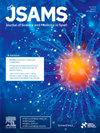Effects of perceived groove in music on cycling performance and intermuscular coherence between trunk and lower limb muscles
IF 3
2区 医学
Q1 SPORT SCIENCES
引用次数: 0
Abstract
Objectives
This study investigated the effects of perceived groove on cycling performance and explored underlying neuromuscular control mechanisms.
Design
Repeated-measures design.
Methods
Twenty-four university students completed the cycling task under three conditions: metronome, low-groove music, and high-groove music. Each task included 3 min of low-torque and 3 min of high-torque cycling. Measurements included pedal cadence, pedal cadence variability, work output, and intermuscular coherence between the trunk and lower limbs.
Results
In low-torque cycling, pedal cadence variability was significantly lower in metronome than in low-groove music and high-groove music; coherence areas (AZ) in the γ band for the erector spinae and soleus were significantly higher in high-groove music than in low-groove music (ps < 0.05). In high-torque cycling, pedal cadence was significantly higher in high-groove music than in low-groove music and metronome, and higher in low-groove music than in metronome, pedal cadence variability was significantly lower in high-groove music and metronome than in low-groove music, and work output was significantly higher in high-groove music than in low-groove music and metronome (ps < 0.05). The AZ values in the α and γ bands for the rectus abdominis and gastrocnemius lateralis and the erector spinae and gastrocnemius medialis and in the γ band for the erector spinae and gastrocnemius lateralis were significantly higher in high-groove music than in low-groove music (ps < 0.05).
Conclusions
Perceived groove during high-torque cycling increased pedal cadence and work output, potentially due to increased cortical and subcortical drive shared between trunk and lower limb muscles.
音乐中感知到的凹槽对循环表现和躯干和下肢肌肉间肌肉一致性的影响。
目的:本研究探讨了感知沟槽对自行车运动表现的影响,并探讨了潜在的神经肌肉控制机制。设计:重复测量设计。方法:24名大学生在节拍器、低槽音乐和高槽音乐三种条件下完成骑行任务。每个任务包括3 min的低转矩和3 min的高转矩循环。测量包括脚踏节奏、脚踏节奏变异性、功输出以及躯干和下肢之间的肌肉间一致性。结果:在低转矩骑行中,节拍器的踏板节奏变异性明显低于低槽音乐和高槽音乐;在高沟音乐中,竖脊肌和比目鱼肌γ带的相干区(AZ)显著高于低沟音乐(ps ),腹直肌和腓肠肌、竖脊肌和腓肠肌内侧肌的α和γ带的Z值,以及竖脊肌和腓肠肌γ带的Z值在高沟音乐中显著高于低沟音乐(ps )。在高扭矩循环中,感知到的凹槽增加了踏板的节奏和功输出,可能是由于躯干和下肢肌肉之间共享的皮质和皮质下驱动增加。
本文章由计算机程序翻译,如有差异,请以英文原文为准。
求助全文
约1分钟内获得全文
求助全文
来源期刊
CiteScore
7.40
自引率
10.00%
发文量
198
审稿时长
48 days
期刊介绍:
The Journal of Science and Medicine in Sport is the official journal of Sports Medicine Australia (SMA) and is an an international refereed research publication covering all aspects of sport science and medicine.
The Journal considers for publication Original research and Review papers in the sub-disciplines relating generally to the broad sports medicine and sports science fields: sports medicine, sports injury (including injury epidemiology and injury prevention), physiotherapy, podiatry, physical activity and health, sports science, biomechanics, exercise physiology, motor control and learning, sport and exercise psychology, sports nutrition, public health (as relevant to sport and exercise), and rehabilitation and injury management. Manuscripts with an interdisciplinary perspective with specific applications to sport and exercise and its interaction with health will also be considered.

 求助内容:
求助内容: 应助结果提醒方式:
应助结果提醒方式:


